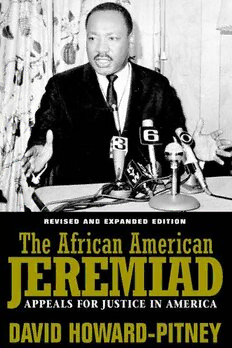
African American Jeremiad: Appeals For Justice In America PDF
Preview African American Jeremiad: Appeals For Justice In America
The African American Jeremiad The African American Jeremiad Appeals for Justice in America REVISED AND EXPANDED EDITION David Howard-Pitney TEMPLE UNIVERSITY PRESS Philadelphia TempleUniversityPress 1601NorthBroadStreet PhiladelphiaPA19122 www.temple.edu/tempress Copyright(cid:1)C 2005byTempleUniversity Allrightsreserved Published2005 PrintedintheUnitedStatesofAmerica TextdesignbyLynneFrost (cid:1)∞ThepaperusedinthispublicationmeetstherequirementsoftheAmerican NationalStandardforInformationSciences—PermanenceofPaperforPrinted LibraryMaterials,ANSIZ39.48-1992 LibraryofCongressCataloging-in-PublicationData Howard-Pitney,David. TheAfricanAmericanjeremiad:appealsforjusticeinAmerica/David Howard-Pitney.—Rev.andexpandeded. p. cm. Rev.ed.of:TheAfro-Americanjeremiad.1990. Includesbibliographicalreferences(p. )andindex. ISBN1-59213-328-2(alk.paper)—ISBN1-59213-415-7 (pbk.:alk.paper) 1.AfricanAmericans—History. 2.AfricanAmerican messianism—History. 3.Socialreformers—UnitedStates—History. 4.Messianism,Political—UnitedStates—History. 5.Civilreligion— UnitedStates—History. 6.UnitedStates—Socialconditions. 7.Jeremiads—UnitedStates. I.Howard-Pitney,David.Afro-American jeremiad. II.Title. E185.H652005 973(cid:3).0496073—dc22 2005040047 2 4 6 8 9 7 5 3 1 Contents PrefaceandAcknowledgments vii Introduction:CivilReligionandtheAnglo-andAfrican AmericanJeremiads 1 1 FrederickDouglass’sAntebellumJeremiadagainst SlaveryandRacism 15 2 TheBriefLifeofDouglass’s“NewNation”: FromEmancipation–Reconstructionto ReturningDeclension,1861–1895 33 3 TheJeremiadintheAgeofBookerT.Washington: WashingtonversusIdaB.Wells,1895–1915 53 4 GreatExpectations:W.E.B.DuBois’sAmerican JeremiadintheProgressiveEra 90 5 MaryMcLeodBethuneandW.E.B.DuBois: RisingandWaningHopesforAmericaatMidcentury 115 6 MartinLutherKing,Jr.,andAmerica’sPromise intheSecondReconstruction,1955–1965 139 7 MalcolmX:JeremiahtoBlacks,DamnerofWhites— totheEnd? 161 8 King’sRadicalJeremiad,1965–1968:Americaasthe “SickSociety” 185 Conclusion:TheEnduringBlackJeremiad 217 Notes 229 Index 269 Preface and Acknowledgments MUCHHASCHANGEDinthefifteenyearssincethefirsteditionof thisbookappeared,butitsmostbasicpresumptionsseemastrueas whenIbegan:Cultures,includingthoseofoppressedandoppressing groups,naturallyinterpenetrateandshapeeachother;Americansstill holdandareinfluencedbymessianicmythsabouttheirnation;and AfricanAmericanjeremiahsstillprotestinjustice. Itispleasingtolearnhowgenerallywellreceivedwasmyoriginal studyofsevenhistoricnationalAfricanAmericanleaders’useofthe Americanjeremiad,arhetoricofindignationexpressingdeepdissat- isfaction and challenging the nation to reform. Black leaders from Frederick Douglass to Martin Luther King and later have employed thiswidespreadrhetoricofsocialprophecyandcriticismtocreatea variantthatisspecificallyAfricanAmerican.Itisalsogratifyingthat Temple University Press believes that the book and response it has receivedmeritthisrevised,expanded,andupdatededition. Significant additions and changes have been made to this second edition. It is more inclusive. I agreed with two reviewers’ point that thefirstbookwouldhavebenefitedfrommoresustainedanalysisof thethoughtandrhetoricofamajorBlackNationalistfigure.Accord- ingly, a chapter has been written on Malcolm X, the famous Nation ofIslamthenindependentblackleaderofthe1950sand1960s.The new chapter on Malcolm adds another fascinating individual and, I think,enrichinganalyticallayertothisstudyoftheAfricanAmerican jeremiadtradition. The Conclusion and Introduction also contain considerable new material.StatementsbyJesseJacksondatingthroughtheearlytwenty- first century are used as evidence, and the jeremiad of African viii PrefaceandAcknowledgments AmericanconservativeactivistAlanKeyeshasbeenaddedtothecon- clusionarysectionontheblackjeremiad’scontinuationinpost-Civil Rights America. I have made cuts in places, such as in Chapter One on Douglass and the Introduction, to keep the second edition from growingtoobulky. To the first edition’s acknowledgments to Professors David W. Noble,SacvanBercovitch,HerbertAptheker,WilsonJ.Moees,Russel Menard, Raymond Arsenault, and Brenda J. Plummer, I now add thankstoProfessorDrewR.Smith,DirectorofthePublicInfluences of African American Churches Project, a project of the Leadership CenteratMorehouseCollegefundedbythePewCharitableTrusts.I amgratefulfortheenliveningacademicacquaintancesImadeamong theproject’sothercommissionedscholars,especiallyProfessorsLewis V.BaldwinofVanderbiltUniversity,ClarenceTaylorofLeMoyneCol- lege, and C. R. D. Halisi of California State University, Los Angeles. Workingontheprojectwasenormouslystimulatingandinfluenced thisrevisededition.IwashonoredtoparticipateinthePublicInflu- encesofAfricanAmericanChurchesProjectandtotakepartinone of the Pew Charitable Trusts’ excellent studies of various American communities’politicalactivities. IthankCynthiaKaufman,mycolleagueinWomen’sStudiesatDe Anza College, whose insights into Ida B. Wells led me to reevaluate Wells’sstatusasajeremiah. I continue to be inspired by the example of historian David W. Noble,myUniversityofMinnesotagraduateadvisor,whoseimpres- sive body of scholarship continues with his latest book Death of a Nation:AmericanCultureandtheEndofExceptionalism. I am very pleased to be teaching at De Anza College and count myself blessed for my work, friends, and family, and especially for Beth,Christopher,andSean.Also,thankstoBethforbeingmyfirst andclosesteditorialadvisor. The African American Jeremiad
